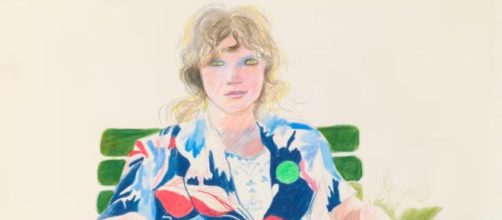This story makes no sense. In its own way, you might say it fits right in with the world we live in.
When David Hockney’s drawings at England’s National Portrait Gallery are compared to Rembrandt’s, you have to wonder why he let his work be vulgarized in a concurrent show of the “immersive” variety, also in England. (I’ll get back to this).
Hockney’s Portrait Gallery show, titled “Drawing from Life,” made from the 1950s to now, is getting raves from British art critics. Ben Luks of the Evening Standard says that Hockney “can match Rembrandt.” And Jonathan Jones of The Guardian, say “no one can draw from life like David Hockney.”
Jones doesn’t stop there, saying “it’s no exaggeration to say that the tiny flicks of the pen in Hockney’s ink sketches match the Dutch master in their elegance.”
'Bigger and Closer' and glitzier
Meanwhile, Hockney’s immersive show at the Lightroom in London titled “David Hockney: Bigger and Closer,” present his paintings with Pop Concert glitz down to piped-in music and the artist’s voice-over commenting on the mountainous magnifications of his easel paintings.
Maybe Hockney’s paintings need special effects. For a long time, I’ve thought his canvases –mostly picturing of L.A. pools and his boyfriends– empty-headed.
Apparently, Jones thinks so, too, panning Hockney’s immersive show as “an overwhelming blast of passionless kitsch.” Not stopping there, he added this knockout punch: “There is no real art to catch the memory or move the soul.”
And the big thing is that not a single image in immersive art shows is the work by the artist. Instead, you get the art of special effects with enlargements of easel paintings so massive that often they not only cover entire walls from floor to ceiling, but also extend to the ceilings and floors, too.
All of which goes to my question: why does Hockney allow immersive treatment of his work?
Other artists who have had the treatment had no say.
Hockney had a choice
Long-gone artists like Van Gogh, Monet, Da Vinci, Goya, Kahlo, and Klimt did not choose immersive presentations for their work. But Hockney did. Why?
Jones unintentionally answered when he wrote. “Hockney in his innocence has lent his fame to a dumb contemporary fad.” “Innocent,” Jonathan?
Hockney is no emerging artist needing flashiness to achieve celebrity. He’s 85 years old and according to the 2012 book “David Hockney A bigger Picture” from the Royal Academy of Art, he is one of the most influential British artists of the 20th century.
Maybe that’s the answer to why Hockney would stoop to the distortion of his work. He wants to be influential in the 21st century.
In that case, David, if you’re listening, drawing transcends time. The art form goes back 30,000 years, when we lived in caves. Few do it as well. You’ve got a lock on it.


